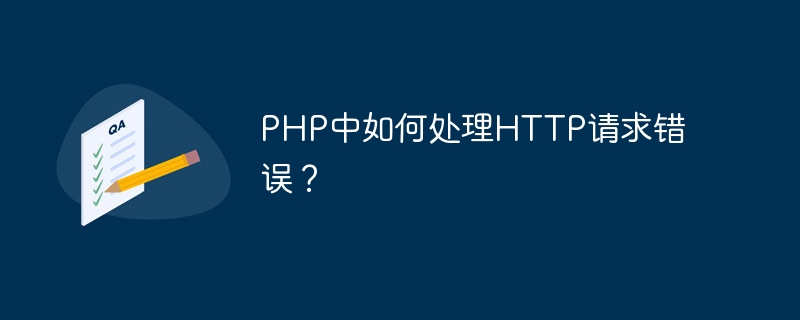

In web development, HTTP request errors are a common problem. It may be that the interface request times out, parameters are passed incorrectly, the network connection is abnormal, etc. In PHP, we can handle these HTTP request errors through various methods. Let’s discuss it in detail below.
1. Use try...catch statement
Using try...catch statement is a common method to handle HTTP request errors. We can use try...catch statement in the code block of HTTP request to capture Exceptions that may occur during the HTTP request process can be handled appropriately. The following is a PHP code example:
try {
$ch = curl_init();
curl_setopt($ch, CURLOPT_URL, $url);
curl_setopt($ch, CURLOPT_RETURNTRANSFER, 1);
$output = curl_exec($ch);
if ($output === false) {
throw new Exception(curl_error($ch));
}
$httpCode = curl_getinfo($ch, CURLINFO_HTTP_CODE);
if ($httpCode !== 200) {
throw new Exception('HTTP error code: ' . $httpCode);
}
curl_close($ch);
} catch (Exception $e) {
echo 'Caught exception: ', $e->getMessage(), "
";
}The above code uses the curl function library to perform HTTP requests, and uses the try...catch statement to capture possible exceptions, such as curl request timeout, network connection exception, etc. Of course, in specific applications, you can add catch statements to capture the errors you want to handle according to specific situations.
2. Use HTTP status code to determine
There are many status codes in the HTTP protocol, which can represent different request statuses. When making an HTTP request, we can determine whether the request is successful by judging the returned HTTP status code. The following is a code example for judging the HTTP request status code:
$url = "http://www.example.com";
$headers = get_headers($url, 1);
if ($headers[0] == 'HTTP/1.1 200 OK') {
echo "HTTP请求成功";
} else {
echo "HTTP请求失败";
}The above code uses the get_headers function to obtain the HTTP response header, and then judges the HTTP status code returned by the header. If it is a 200 status code, the request is successful. .
3. Use PHP error functions
PHP provides some error handling functions, such as error_reporting() and ini_set(), etc. We can use these functions to custom handle HTTP request errors. The following is a code example that uses the PHP error function to handle HTTP request errors:
error_reporting(E_ALL); //指定PHP错误等级
ini_set('display_errors', 1); //开启错误提示
$url = "http://www.example.com";
$response = file_get_contents($url);
if (!$response) {
trigger_error("HTTP请求失败!", E_USER_ERROR);
}In the above code, we use the PHP error handling function trigger_error(). When the HTTP request fails, a custom error information and handle it accordingly.
4. Use third-party HTTP request libraries
In addition to using PHP’s own function library for HTTP requests, there are many third-party HTTP request libraries that can be used, such as Guzzle, Requests, etc. wait. These libraries usually provide easier-to-use and more feature-rich APIs, making it easier for developers to handle HTTP request errors. The following is a code example that uses the Guzzle library to perform HTTP requests:
use GuzzleHttpClient;
use GuzzleHttpExceptionConnectException;
use GuzzleHttpExceptionRequestException;
$client = new Client();
try {
$response = $client->request('GET', 'http://www.example.com');
$httpCode = $response->getStatusCode();
if ($httpCode !== 200) {
throw new Exception('HTTP error code: ' . $httpCode);
}
} catch (ConnectException $e) {
echo "网络连接异常";
} catch (RequestException $e) {
echo 'HTTP请求异常:' . $e->getMessage();
} catch (Exception $e) {
echo '其他异常:' . $e->getMessage();
}The above code uses the Guzzle library to process HTTP requests, and handles possible exceptions, such as network connection exceptions, HTTP request exceptions, etc.
Summary:
Whether we use PHP’s own function library or use a third-party library to make HTTP requests, when handling HTTP request errors, we need to pay attention to how to capture and handle exceptions. If there is no effective error handling method, it may cause the program to crash and have a negative impact on the user's use.
The above is the detailed content of How to handle HTTP request errors in PHP?. For more information, please follow other related articles on the PHP Chinese website!